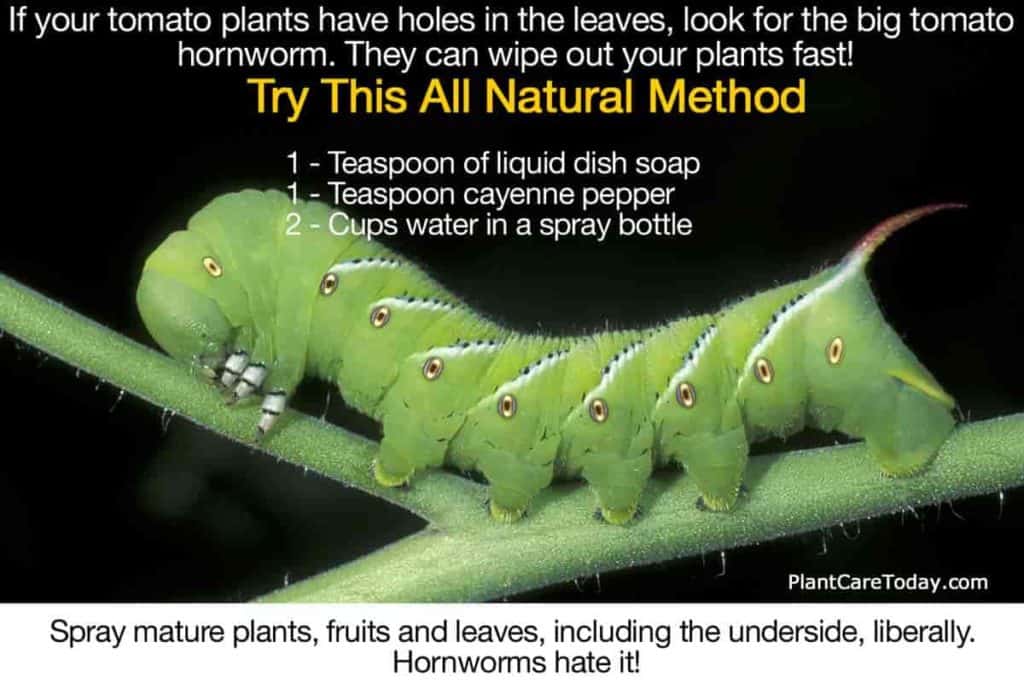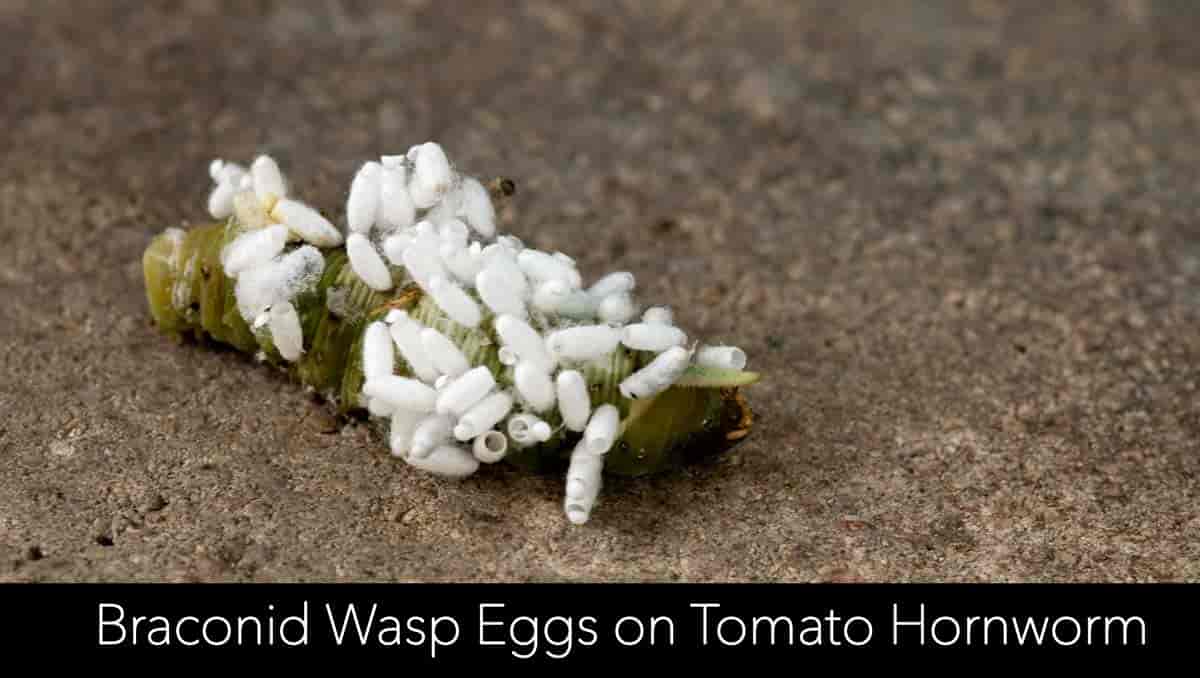Tomato worms or tomato hornworm Manduca quinquemaculata is a very common big green caterpillar with a horn in North America.
The tomato caterpillar eats a wide variety of popular veggie host plants including members of the Hemlock family, such as:

- Tomato plants
- Potato
- Pepper
- Eggplant
The tobacco hornworms Manduca sexta wreak havoc on tobacco crops. These enormous and rather dazzling-looking tobacco worm caterpillars are relentlessly destructive.
- Our Top Organic Insecticides For Getting Rid Of Tomato Worms
- What Do Tomato Hornworms (Big Green Caterpillars) Look Like?
- Where Do Tomato Worms Come From? The Tomato Worms Life Cycle
- How Can You Find These Large Tomato Caterpillars?
- How To Get Rid Of Tomato Hornworms And Its Caterpillars?
- 9 Ways To Practice Prevention
- Vary Your Pest Control Methods To Control Hornworms In Your Garden
They eat leaves whole and also cause massive damage to stems, fruits and plants as a whole.
Our Top Organic Insecticides For Getting Rid Of Tomato Worms
Tomato hornworms share some characteristics with the tobacco hornworms.

Even though they are large and flashy looking, they can hide with ease in the vegetable garden because their coloring and markings tend to blend in with the crops and plants they pillage.
For this reason, you may find yourself surprised by areas of mass destruction of a big green caterpillar without ever having seen one of these little devils at work.
You are most likely to find this damage beginning in midsummer, and if you don’t put a stop to it, the tomato hornworm can ruin your entire growing season and your crops.
In this article, we share advice for identifying and dealing with these green worms on tomatoes early and efficiently. Read on to learn more.
What Do Tomato Hornworms (Big Green Caterpillars) Look Like?
Tomato hornworms (aka Manduca quinquemaculata, the Five-spotted Hawk moth) are quite large.
The five-spotted hawkmoths also measure between three and six inches long, and they are quite sporty with a bright green body, seven white stripes running diagonally, and a prominent red or black horn at the rear end.

The parent moths are also quite large, with four or five-inch wingspan. The moths are brown or gray with zig-zagging white markings on the wings and brown or orange spots on their heavy bodies.
You may have heard these moths referred to as Hawk Moths or Sphinx Moths. They are rather impressive because they can fly very fast and they can hover like hummingbirds. Sometimes, they are called hummingbird moths because of this.
Where Do Tomato Worms Come From? The Tomato Worms Life Cycle
Where do tomato worms come from? The pupae overwinter in the soil. At this stage, they are dark brown.
In the late spring, adult moths emerge from the soil and mate. Then they lay their eggs, which are green and spherical, on the underside of a leaf of their chosen plant.

The tomato hornworm eggs hatch from the leaves within five days, and the larvae begin their above-ground life cycle. This is a multi-stage process that is completed within a month.
At the end of the month, the tomato worms burrow beneath the soil and become larvae. This stage lasts for two to four weeks. At the end of the larval stage, adults emerge to mate and lay eggs.
This cycle is completed twice annually, so you will see new adults emerging from your garden in late spring and again in the mid-summer.
Related Reading: Does Diatomaceous Earth Kill Hornworms?
How Can You Find These Large Tomato Caterpillars?
If you notice Sphinx Moths around your garden or your porch light at night, you should begin looking for their eggs and small caterpillars amongst your crops.
Look at every tomato leaf if you can. Catching them early is key to control.

Signs of a tomato hornworm caterpillar garden infestation include black caterpillar droppings (frass) on the ground around your plants and the leaves.
How To Get Rid Of Tomato Hornworms And Its Caterpillars?
A single green-horned tomato worm can consume all of a plant’s leaves in a very short period of time. This large green caterpillar has a voracious appetite and eats constantly, so they grow very large very quickly.
They can grow as large as six inches in length and one inch in girth.
Follow these tips to eradicate hornworms from your garden:
1. Check your plants every day for signs of these pests. These signs include:
- Chewed leaves
- Caterpillars
- Frass
- Eggs
What do caterpillars eat? Note that when green tomato worms eat leaves, they usually leave the veins and only eat the flesh of the leaf. When you see this, you can be sure you are dealing with hornworms. More on Caterpillars eating leaves.

2. Be thorough! Scan both sides of the leaves and look around on the ground for signs of worms on tomato plants. Be aware that hornworm poop is quite large. In fact, you may even mistake them for rabbit droppings.
3. At the early stage, you can just give the foliage a good, vigorous spraying with plain water to knock small caterpillars off and drown them. This goes a long way toward solving your problem.
4. In addition to a visual inspection and spraying with water, try spraying your plants with a solution of dish soap and water. This spray mixture causes the caterpillars quite a bit of distress.

They’ll move around trying to get away, and you will be able to see them and catch them. Just drop them into a bucket of soapy water to finish the job.
TIP: Wear gloves when picking off hornworms by hand because they will attempt to defend themselves by spitting “tobacco juice” (dark brown liquid) onto your hand.
9 Ways To Practice Prevention
You can prevent tomato worms from returning to your garden by taking a few simple precautions.
1. When you till up your garden soil, keep an eye out for hornworm larvae. They look like small, brown torpedoes. Pick them out and drop them in a bucket of soapy water.
2. Don’t plant the same crops in the same place year after year. Crop rotation helps keep all pests off guard. Never plant any type of nightshade varieties in the same place from one year to the next. For example, when you rotate your tomato plant crops (for example), you should not replace them with potatoes or another type of nightshade.

3. Cover the ground around your tomatoes in the nightshade family with sheet of black plastic mulch. The plastic helps block the emergence of the adults from the soil in the late spring.
4. Spray your garden with a natural mixture of water, cayenne pepper powder, insecticidal soap, and garlic to prevent Sphinx Moths from laying eggs on your plants.
- Ants
- Bedbugs
- Fleas
- Cockroaches
- Silverfish
- Beetles – Flour, Darkling, Grain, Carpet, and Colorado Potato beetles
- Earwigs (pincher bugs)
- Centipedes, Millipedes, Sowbugs and Pillbugs
- Spiders
- Crickets
- Slimy slugs and snails
5. Make your yard a haven for caterpillar-eating birds. Be sure to set up bird baths and feeders in your yard and garden to enlist the help of these natural predators. Mockingbirds, Robins, and other larger, carnivorous, and omnivorous birds are very fond of big, juicy hornworms.

6. Decoy hornworms with a trap crop. Planting a crop of dill may help keep hornworms off your hemlock crops. They prefer this plant, and having them gathered around it will make it easier for you to find them and eliminate them.
7. Encourage the presence of parasitic wasps, a natural enemy. These wasps lay eggs on hornworms’ backs. When the eggs hatch, the wasp larvae eat the hornworms.

8. Place pop-up bird netting around individual plants. It is supposed to keep birds away from your fruit, but hornworms are so big that they cannot get through the mesh either. This solution is a bit cumbersome because these nets are rather expensive. Also, they do nothing to prevent pupae in the form of tomato hornworm moths from emerging from the soil.
9. Make wise use of Bacillus thuringiensis bt. This organic pesticide consists of a form of bacteria that is very effective in poisoning young caterpillars but has no effect on other garden fauna. The strain of Bt, which is known as Thuricide, is an excellent choice for controlling hornworms.
You simply mix the liquid or powdered concentrate with water and spray your tomato plants with it early on to catch hornworm caterpillars before they can do much damage.
Because this solution is caterpillar-specific, remember that it will also kill butterfly caterpillars, so apply it carefully and keep it away from your butterfly garden and individual plants that butterfly caterpillars enjoy.
10. Attract beneficial insects. In addition to predator braconid wasps, a number of other beneficial insects lay waste to hornworms by eating the eggs. Be sure to protect and encourage ladybugs, green lacewings, and trichogramma wasps.

Vary Your Pest Control Methods To Control Hornworms In Your Garden
It is important to use a wide variety of ways to control and eliminate hornworms because they can build up resistance and learn workarounds for just about anything you do if you only do one thing. Keep them on their toes by varying your methods throughout the growing season.
A good technique is to use bt Bacillus thuringiensis early on. Give it 48 hours to dissipate, and then introduce predatory insects to your garden to keep your hornworm numbers low. At the end of the growing season, be sure to till your garden.

This disrupts the soil and interferes with the pupae underground. Some studies show that tilling can kill as much as 90% of buried larvae. As mentioned, if you see hornworm pupae when you till, collect and destroy it.
When you see hornworms with parasitic wasp cocoons on board, collect them and keep them in an area of discarded or volunteer hemlock crops or dill.
Allow the wasps to hatch and eat the hosts. Then, you will have a beautiful, healthy crop of predator wasps to continue helping you year after year.
